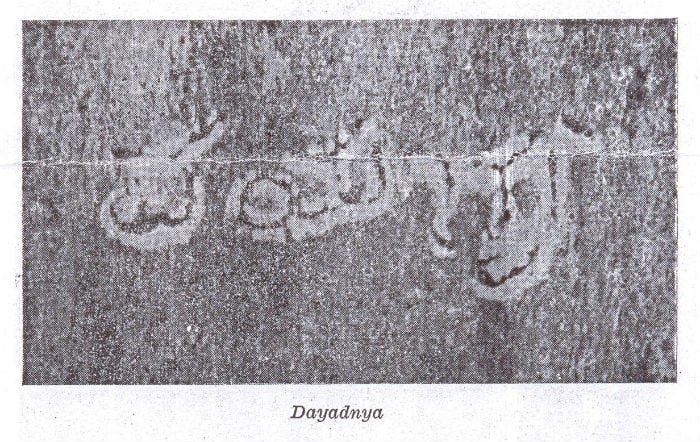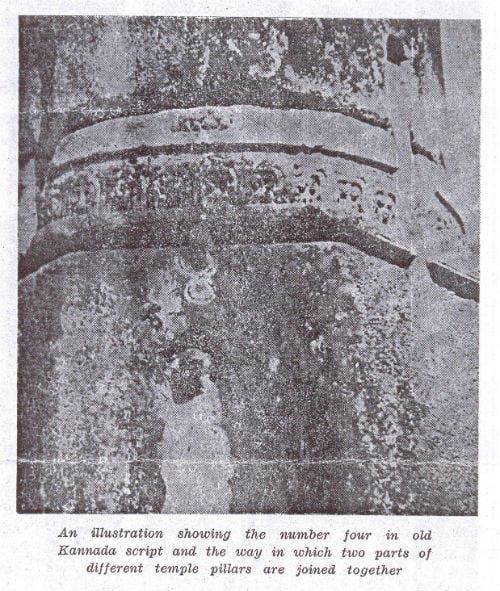Struggle for Hindu Existence
*Hindu Rights to Survive with Dignity & Sovereignty *Join Hindu Freedom Movement to make Bharat Hindu Rashtra within 2025 *Jai Shri Ram *Jayatu Jayatu Hindu Rashtram *Editor: Upananda Brahmachari.
Hindus must remember Goa’s ‘Hatkatro Khaamb’ on Christmas and New Year.
Hatkatro Khaamb : A lone pillar that stands witness to horrors of inquisition, Hindus must remember it in Christmas and New Year.

Hatkatro Khaamb: At present.
Anand Shinde | HENB | Goa | Dec 25, 2023:: Some 10 years ago, on Dec 25th, when some people from local churches wanted to distribute gifts of old garments, cakes, chocolates and other pleasantries from an alter beneath an old pillar in old Goa to celebrate the Christmas and New Year; the local Hindus vehemently protested.
The pillar is known as “Hatkatro Khaamb”, Through this pillar, history tells how much oppression was done on Hindus in Goa. Those who refused to convert in Christianity were tied to these pillar and had their hands were cut off. Christians are painted as the symbol for spreading the message of love, compassion and peace to the world but the people of Goa do not believe that. They remember how their ancestors were brutally killed by being tied to this pillar. Many Hindus celebrate Christmas by making their sons as ‘Santa Claus‘, cutting cakes, erect Christmas Tree, but they don’t know the brutality of Christians whether Protegees or Britishers. Hindus should visit Goa once and see this pillar. India has a horrific history of brutality and persecution by Christian clergy and colonial rulers.
Hath Kataro Khambh of Goa was used to tie and amputate arms of those Hindus who refused to convert to Christianity. This is blood-stained history of Goa which no one wants to discuss. The crimes done by Francis Xavier (co-founder of the Society of Jesus) and his associates on Hindus.
It is believed that 80000+ Hindus hands were cut off near this pillar of which 50% are konkan Brahmins. One who ordered this was Francis Xavier. Thousands fled to the present state of Maharashtra and Karnataka He was rewarded for his brutality and conversions and later made a saint.
The Hindu Janajagruti Samit (HJS) website gives us a vivid description of Hatkatro Khaamb:
Where the Kadamba by pass converges at Old Goa stands a tall and slender column. It is a very intriguing pillar. This elegant pillar quitely narrates a tale of woe. In local it is popularly called the ‘Hatkatro Khambo’ literally meaning a pillar where hands were chopped.
It is a relic of an ancient temple and going by some portions, it appears to be from the Kadamb era, cirac 12th – 13th century AD,when Portuguese razed several temples and used the relics of the temple such as the pillars, capitals, doorframes and window to decorate their own structures in the 16th and 17th centuries.

The inquisition was the darkest and most dreaded chapter in the history of colonial Goa. It was introduced in October 1560 at Old Goa. The Hatkatro Khamboo today is a symbol of the horrors of inquisition let loose by the Portuguese ecclesiastical authorities on the Hindus.
On the Hatkatro Khamb of Old Goa there is a short Halle Kannada inscription, which must be of the ancient temple from Kadamb era.
The inscription which reads as ‘DAYADNYA’ alongwith the number four in Kannada was discovered by Dr. P. P. Shirodkar, Director of Archives, Archaeology and Museum when he had gone over there on October 15 to look for the vestiges if any of the dreaded Goa Inquisition.
 The inscription remained undetected for centuries probably on account of the fear traditionally associated with this monument id the Inquisition. The New Pillory notoriously called as ‘Hatkatro Khambo’ by the local people had been constructed by the end of the 16th century when the Old Pillory which stood close to the rotunda of the statue of Mahatma Gandhi was abandoned. These pillories served as the devices for publicly punishing the offenders of the law who on being tied to it were whipped. At times, it was used to disjoint the hands by twisting the cords so tightly that the victim used to lose the upper limbs permanently. That’s the reason why the local people have continued to call it ‘Hatkatro Khambo’ (Hand cutting Pillar). It lies at the foot of the mount of the Cross of Miracles, on way to Neura.
The inscription remained undetected for centuries probably on account of the fear traditionally associated with this monument id the Inquisition. The New Pillory notoriously called as ‘Hatkatro Khambo’ by the local people had been constructed by the end of the 16th century when the Old Pillory which stood close to the rotunda of the statue of Mahatma Gandhi was abandoned. These pillories served as the devices for publicly punishing the offenders of the law who on being tied to it were whipped. At times, it was used to disjoint the hands by twisting the cords so tightly that the victim used to lose the upper limbs permanently. That’s the reason why the local people have continued to call it ‘Hatkatro Khambo’ (Hand cutting Pillar). It lies at the foot of the mount of the Cross of Miracles, on way to Neura.
During the last century, as illustrated by Sr. Lopes Mendes in his book A India Portgueza, it had seven laterite steps for the victims to climb up and it served as a platform for the pillory. But during the present century it has been repaired and since it is in disuse no steps have been provided except about 31/2 ft. partly plastered platform of laterite.
The Pillory which formed two different parts pf the pillars of the old temple were joined together by iron rings to keep it erect. The upper portion with the capital at the top is round in shape and the lower portion is SRIDHARA i.e. an octagonal pillar with a square base. It has roundish ornamental sculpture above it, which had formed as a base for fixing the upper pillar. The inscription is at the foot of the pillar and the number four is just below the ornamental round part above.
The existence of the inscription gives credence to the belief that the two parts of the pillory were originally the pillars of the old temple and most probably of the old Shiva temple of Saptanath in Malar area of Divar the stones of which had been used under instruction from the Portuguese authorities for construction of the churches and convents at Old Goa. The Saptanath temple had been erected by Madhav Mantri, a Minister of the Vijaynagar Kingdom in 1931 A.D. which was subsequently destroyed during period of Bahamani rule in 1471 and later on by the Portuguese. In 1515, Fr. Andre Corsali, a resident from Florence while writing from India had described it as one of the best Temples he had ever seen and that its sculpture and architecture far surpassed the European stone ornamentation.
 The word ‘DAYADNYA’ on the pillar may be a reference to Lord Shiva, who is considered as ‘one who shows mercy’. The number four probably refers to four sects of Shaivism namely Kapalic, Kalamukh, Pashupat and Shaiva. This leads one believe that it might have been a part of the pillar of a Shiva temple which could be of only one in the vicinity of Old Goa, i.e. Saptanath of Divar. Incidently, it can be pointed out that the exquisitely carved pillar probably a Deepstambh of the same temple still stands in the inside compound of the Museum of the Archeological Survey of India at Old Goa and its upper portion with arrangement for wicks and oil has been used as a Baptismal Font at the door of the Church of St. Francis of Assisi.
The word ‘DAYADNYA’ on the pillar may be a reference to Lord Shiva, who is considered as ‘one who shows mercy’. The number four probably refers to four sects of Shaivism namely Kapalic, Kalamukh, Pashupat and Shaiva. This leads one believe that it might have been a part of the pillar of a Shiva temple which could be of only one in the vicinity of Old Goa, i.e. Saptanath of Divar. Incidently, it can be pointed out that the exquisitely carved pillar probably a Deepstambh of the same temple still stands in the inside compound of the Museum of the Archeological Survey of India at Old Goa and its upper portion with arrangement for wicks and oil has been used as a Baptismal Font at the door of the Church of St. Francis of Assisi.
Even then, Monks of Ramakrishna Mission or many other Hindu Religious organisations, who are so eager to spread harmony and love by celebrating Christmas and New Year after suppressing the facts of ‘Hatkatro Khaamb’ or many testimonials of Christian persecution on ‘Heathen’ Hindus in India and abroad, are just preparing the filed of conversion in favour of Jesus and his Gospels.
…
_Inputs from HJS.


More people's loosing hopes on judiciary system. It has become a tool for criminals than getting justice.
With due respect to the sender and promoters of this media group, almost everyone at the management post in VHP…
[…] 1 000 filles hindoues sont converties de force chaque année… […]
What's the reaction of the CM of Telangana? ________________________________
Each visitor(devotee) entering the temple must be thoroughly checked and let in to the temple.